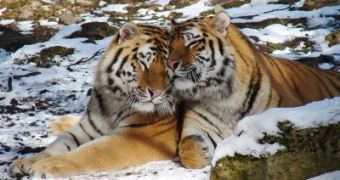It is a commonly held belief that cats are not very flexible when it comes to changing their behavioral patterns so as to better work their way around human schedule.
Up until recently, it was considered that big cats are no different to your ordinary pets, at least from this standpoint.
However, according to a study recently published in the Proceedings of the National Academy of Sciences, the tiger population presently living in Nepal has agreed to make a compromise and only go out hunting or on patrol during nighttime, when the people living in their close proximity are resting.
As the researchers who looked into this peculiar phenomenon explain, tigers typically go out both during the day and during the night, as they need to keep a close eye on their territory, find suitable mates or locate prey.
Still, because in Nepal these big cats are forced to share their natural habitats with human communities, it seems that the felines living in this part of the world now more often than not choose to only roam the lands once the night has fallen, and remain hidden during the day.
Apparently, this finding is of utmost importance when it comes to implementing conservation projects, as it goes to show that one need not necessarily relocate tigers in order to make room for human communities, and – in turn – people need not be driven off their lands in order to establish wildlife sanctuaries.
The official website for the Michigan States University quotes Neil Carter, a doctoral student who spent two seasons monitoring the tiger population in Nepal by means of motion-detecting cameras, and who found that the humans and the big cats in this part of the world move through the lands in very much the same way, only that they do it within very different time-frames.
As he explains, “Tigers need resources, people need the same resources. If we operate under the traditional wisdom that tigers only can survive with space dedicated solely for them, there would always be conflict. If your priority is people, tigers lose out. If your priority is tigers, people lose out.”
Hopefully, this research will yield some benefits in terms of protecting our planet's big cats population, as it goes to show that reaching a middle ground is indeed possible when it comes to co-existing with wildlife.

 14 DAY TRIAL //
14 DAY TRIAL //